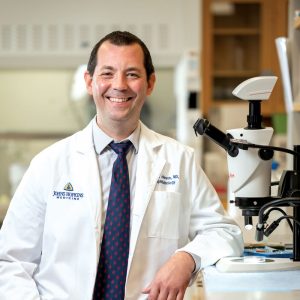Thomas Johnson III, MD, PhD, is on a mission to turn findings in the lab into therapies that will dramatically improve the lives of patients. An assistant professor of ophthalmology, he leads a translational neuroscience laboratory at the Johns Hopkins Wilmer Eye Institute that focuses on stem cell transplantation to regenerate damaged optic nerves. This work has the potential to someday restore vision damaged by conditions like eye stroke and diseases like glaucoma, the world’s second-leading cause of blindness.
Cindy Cai, MD, another assistant professor of ophthalmology at Wilmer, is focused on how social determinants of health — like lack of insurance and transportation — lead patients with diabetes to have lapses in their ophthalmology care, which decreases the likelihood of prompt intervention and can lead to poor outcomes.

While their focus differs, Cai and Johnson are both able to advance their research through Wilmer’s Rising Professorship program. Funded with individual philanthropy, the program provides support for assistant professors that is equivalent to Wilmer’s traditional professorships for senior faculty members. That means a tremendous jump in resources for researchers like Cai and Johnson who are still beginning their careers.
“A rising professorship is an opportunity for our best and brightest to get their research programs up to speed years sooner than would happen through the traditional standard pathway,” says Wilmer Director Peter J. McDonnell, MD, counting off some of the issues that the new professorships will address.
First, the competition for resources in the biomedical field is fierce, and younger researchers are disadvantaged compared to established scientists with large teams. Clinician-scientists like Johnson and Cai are often closest to the patients and their needs and concerns, but they don’t always have the opportunity to transfer that practical knowledge into research. Finally, the average age for a standard biomedical grant from the National Institutes of Health is 45, resulting in perhaps 20 years of research before retirement.
Speeding up research time is what the Allan and Shelley Holt Rising Professorship, held by Johnson and part of the Sanford and Susan Greenberg Center to End Blindness at the Wilmer Eye Institute, aims to do.

For Allan Holt, a member of Wilmer’s board of governors, the professorship that bears his and his wife’s names is personal. Two close family members suffered vision loss from non-arteritic anterior ischemic optic neuropathy (NAION), a disruption of the blood flow to the optic nerve.
He’s inspired by the prospect of someday ending blindness. “It’s a noble goal,” he says. “And it’s near and dear to me because two family members had NAION. Other family members might have it potentially down the road.”
Johnson, who calls the rising professorship “transformative” for his work, estimates that with the new resources, he can conduct the experiments he expected to take three years in just half that time.
In addition to advancing research, accelerating career growth inspired Jonathan Javitt, MD, MPH, and Marcia Javitt, MD, to establish the inaugural Rising Professorship at Wilmer.

“If we don’t implement formal mechanisms to support the most promising junior faculty members, our academic future will be far less rich than our academic past,” says Javitt, a former Wilmer faculty member who is now CEO and chair of NRx Pharmaceuticals. “The key objective of the Rising Professorship program is to build resources within Wilmer to continue its global leadership for at least another century.”
The Jonathan and Marcia Javitt Rising Professorship provides funding, mentorship, and leadership training to one assistant professor, currently Cai, at Wilmer. The mentorship component of the rising professorships is led by Henry Jampel, MD, the Odd Fellows Professor of Ophthalmology at Wilmer and a glaucoma specialist. He advises the rising professors on establishing their research trajectory, developing a consistent voice as peer-reviewed authors, taking on national leadership roles, and contributing to editorial boards.
“The idea is to get them to that next level in their careers much faster,” Jampel says. “This happens by giving them extra funds and protected time to further their research. And then we add in leadership courses to make them even better researchers and administrators.”

Cai says working closely with Jampel is an important part of the program. “He’s very well-connected to lots of researchers at Hopkins, so he is a very valuable resource to all of us,” says Cai, who specializes in the medical and surgical treatment of retinal diseases.
Cai is using data in the electronic medical record, as well as national data, to study the lapses in care for patients who have been diagnosed with diabetic retinopathy — a condition that causes blindness and is expected to afflict more than 14 million people by 2050, according to the National Eye Institute. She is drawing from U.S. census data to leverage information on the neighborhood level, focusing on statistics such as the percentage of people who live below the poverty line and who own a car, to help predict which patients might have gaps in ophthalmology care.
“The idea is that hopefully in the future, we can highlight the population of patients with diabetes who are at high risk for a lapse in their care, and we can offer them support for their social needs,” Cai says.
Through the rising professorship, Cai had the funding to hire a research assistant to help with analytics and potentially make her research progress even faster. “The rising professorship can only advance our careers more quickly,” Cai says. “It’s a huge opportunity for all of us.”
This story was adapted from “What the Future Holds” and “Accelerating the Careers of Wilmer’s Rising Leaders” on the Johns Hopkins Medicine website.
Topics: Faculty and Staff, Friends of Johns Hopkins Medicine, Wilmer Eye Institute, Fuel Discovery